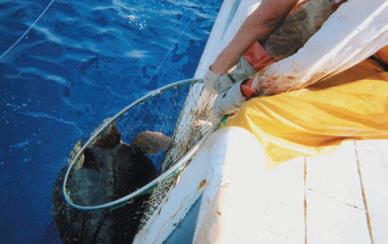
3 minute read
New Model Shows Hawai‘i Shallow-Set Longline Fishery Has Minimal Impact on Turtle Populations
New Model Shows Hawai‘i Shallow-Set Longline Fishery Has Minimal Impact on Turtle Populations
The Hawai‘i shallow-set longline fishery has little to no discernible impact on the population levels of loggerhead and leatherback turtles. That was the finding of a new Population Viability Assessment model developed by the National Marine Fisheries Service (NMFS) Pacific Islands Fisheries Science Center (PIFSC). The model was presented to the Western Pacific Regional Fishery Management Council at its 180th Council meeting held in October 2019 in American Samoa. The model’s results will be published in a NOAA technical memorandum in early 2020.
Advertisement
The fishery, which produces 55 percent of the domestic US catch of swordfish, is one of the most highly regulated and monitored longline fisheries in the entire Pacific with 100 percent federal observer coverage. Since 2004, every

A live loggerhead turtle is brought onboard a longline vessel with a dip net to allow for safe removal of fishing gear.
NOAA NMFS
shallow-set longline trip has carried a federal observer, who collects data on target and non-target fish as well as any interactions with protected species, such as turtles, seabirds and marine mammals. The shallow-set longline fishery is also required to use circle hooks and fish bait designed to reduce accidental interactions (meaning hooking or entanglement) with sea turtles, and take additional steps to reduce impacts to seabirds. Over 99 percent of the sea turtles observed interacting with the fishery since 2004 were released alive.
PIFSC’s model analyzed the impacts of the future anticipated level of interactions in the Hawai‘i shallow-set longline fishery on the loggerhead and leatherback turtle populations over the next 100 years. The anticipated level analyzed was equal to or less than 36 loggerhead turtle interactions per year and equal to or less than 21 leatherback turtle interactions per year. The results of the model showed no discernable impact of the fishery’s interactions on the population trend of loggerhead turtles over the next 100 years. For leatherbacks, it showed a small change in the long-term population trend, indicating that the population impact from the fishery would
occur five years earlier at the end of the 100-year period. The model also indicated that the past take made no discernable difference on the historical population trend. The model is considered to be conservative because the impacts of the interactions are only applied to index beaches, which account for about 52 percent of the loggerhead population and about 75 percent of the leatherback population. A PIFSC scientist noted that the primary impacts on the leatherback population include directed fisheries and nesting predation where the turtles nest in Indonesia and Papua New Guinea.
These model results further support the conclusions of a biological opinion (BiOp) issued by NMFS in June 2019 that the Hawai‘i shallow-set longline fishery is not likely to jeopardize the continued existence of species listed under the Endangered Species Act. Nevertheless, the BiOp required implementation of additional mitigation measures to minimize the impacts of the interactions, including a fleetwide hard limit of 16 leatherback turtles annually (after which the fishery must close for the remainder of the year) and interaction limits for each shallow-set trip that would require vessels to return to port if they reached a limit. The Council at its 179th meeting in August 2019 took final action to implement these management actions (see Pacific Islands Fishery News Summer 2019).
At its 134th meeting in October, the Council’s Scientific and Statistical Committee (SSC) endorsed the take model developed for the shallow-set longline fishery as the best scientific information available for evaluating the impacts of the fishery on loggerhead and leatherback turtle populations. The SSC further recommended that PIFSC apply the model to the interaction data for the Hawai‘i deepset longline fishery (which targets bigeye tuna) and the American Samoa longline fishery (which targets albacore tuna) to provide a robust scientific assessment to be considered in the upcoming BiOps for those fisheries. The Council at its 180th meeting urged NMFS to consider all anticipated scientific information, including the PIFSC model, in the BiOp for the Hawai‘i deep-set and American Samoa longline fisheries.
The Council will additionally work with NMFS to evaluate the impact of any management actions for reducing turtle interactions on the economic performance and socioeconomic effects of the shallow-set and deep-set longline fisheries, including consideration of the effect on protected species being transferred to foreign fisheries should the US longline fishery close. It also recommended that NMFS work with the Council to develop only necessary sea turtle protection measures under the ongoing consultations for the Hawai‘i deep-set and American Samoa longline fisheries that are appropriate and practicable and ensure the sustainability of the fisheries.



